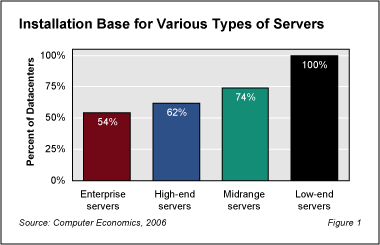Many IT professionals are under the impression that mainframe computers have strong cost-performance characteristics. But recent data from Computer Economics challenges that assumption, especially when mainframes are used in a mix of with other classes of servers in the same data center.
In spite of their legacy image, mainframe computers still occupy a major position in the hardware inventory of many data centers, especially in certain industries such as banking, finance, and insurance, and among larger companies. Our most recent IT spending survey of over 185 CIOs and senior IT managers showed that over half of the respondents still have mainframe systems installed.
However, a deeper analysis of the statistics collected in our survey indicates that, although the technical performance of mainframes may be good, the economic performance of mainframes is not as good as that of other hardware platforms, especially in data centers where mainframe computers are used in a mix with other classes of servers. For organizations with such a heterogeneous server mix, these findings may be used to justify migration of mainframe applications to other server platforms or, at a minimum, undertake a mainframe server consolidation strategy.
This Research Byte is a summary of our full article, The Case for Mainframe Migration and Consolidation, which is available for purchase on our website.
Why Organizations Run Mainframes
Mainframes (or, as more recently branded, enterprise servers) are unlikely to disappear from large corporate data centers in the near future. First, companies often need enterprise servers to run custom legacy applications, which are often considered too costly to port to smaller systems. Additionally, the lack of standardization among the various server vendors can lead to excessive costs in any migration. The incompatibilities between various servers cause inefficiencies in running many different server configurations. Consequently, managers lose economic control and ownership costs exceed the budget.
Second, large mainframe systems tend to have extensive procedures and processing steps in both the data center and end-user areas involving data entry, batch interfaces, and dependencies with other systems that make them difficult to simply convert to other platforms.
Third, there is no denying that the reliability and scalability of enterprise servers is excellent, continuing to make them a good choice for applications that have both high availability and high transaction processing requirements.
For these reasons, it is understandable that many IT organizations are in no hurry to move away from their mainframe platforms. However, while IT management may use various rationales to justify running a mix of servers, the truth is that a heterogeneous hardware mix that includes enterprise servers often delivers poor economic returns.
Enterprise Servers Are Widespread
In our survey, we classified servers into four categories:
- Enterprise servers (mainframes)—regardless of cost
- High-end servers—costs in excess of $750,000
- Midrange servers—costs between $250,000 and $750,000
- Low-end servers—costs below $250,000
Figure 1 shows the installed base of each category of server. Enterprise servers are in use at 54% of the data centers. Sixty-two percent of the sites use high-end servers. Midrange servers are employed by 74% of the centers. Every participant in our survey reported using low-end servers. As these results indicate, many data centers are burdened with a heterogeneous mix of servers.

The full version of this article, The Case for Mainframe Migration and Consolidation, provides data on the percentage of the IT budget allocated to the four categories of server hardware shown in Figure 1. It also provides an analysis of the growth of high-end servers, mid-range servers, and low-end servers in data centers where mainframes are part of the processor mix. Finally it presents the percentage of survey respondents that experienced positive ROI on their mainframe investment, and the percentage that found the total cost of ownership (TCO) of mainframes to be greater than budgetary expectations.
In view of this analysis, the technical advantages of enterprise servers lose their appeal. Managers should investigate the economics of enterprise servers within their organizations and, if costs are out of line, a strategy to eliminate or reduce mainframe presence in the data center should be seriously evaluated.
April, 2006
This Research Byte is a summary of our full article, The Case for Mainframe Migration and Consolidation, which is available for purchase on our website.




